Hair Tattoo: Understanding the Intricacies of Hair Tattoos
Hair Tattoo – For the millions of individuals who grapple with hair loss, the quest to find a solution can often lead to an arsenal of treatments, products, and, of course, the myriad of information that comes with them. In this expansive world of hair restoration, one intriguing avenue is often overlooked or misunderstood: hair tattoos. Also known as scalp micropigmentation (SMP), this technique offers a creative and effective approach to resolving hair loss. However, many are unaware of the nuances that make it a mighty contender in the battle against baldness.
As we explore hair tattoos in-depth, we’ll uncover the facts and dispel the myths. Poviding the essential understanding that’s crucial for anyone considering this artful solution to restore their hairline.
For those looking for specific parts of the post, please click the highlighted text that is most relevant.
Hair Tattoo vs. Hair Transplant
The Essence of a Hair Tattoo: What Is It?
Fine dots of specialized pigment are inserted into the dermal layer of the scalp, meticulously creating the look of a full head of hair. This is SMP, or scalp micro pigmentation, a non-invasive treatment suitable for individuals at various stages of hair loss. The goal: to replicate the natural appearance of hair follicles. The finished result is he illusion of a closely-cropped hairstyle. Furthermore, SMP can be used to create the appearance of density in thinning hair.
Unlike traditional tattooing, SMP artists use distinct needles and inks designed to match the client’s natural hair colour. This permanent cosmetic solution mimics the precise angles and densities of natural hair growth. For those with significant hair loss, SMP offers a way to restore hairlines with the appearance of a buzz cut. Follicle replication can also help conceal scars from previous hair transplant surgeries.
In essence, a hair tattoo is a form of medical tattooing. It can complement other hair restoration methods or stand alone as a discreet and low-maintenance highly effective solution.
Who Is Best Suited for SMP?
Understanding the potential candidates for SMP is vital in managing expectations and delivering realistic results. Unlike some surgical procedures, this method is minimally invasive and offers the benefit of immediate results. That is a major benefits as there’s no waiting for hair to grow.
The ideal candidates may include:
- Individuals with pattern baldness looking to maintain a closely-shaved hair style
- Those who’ve undergone hair transplant surgeries to fill in thin areas or scar camouflage
- Those who’ve undergone hair transplant surgeries to fill in thin areas or scar camouflage
- Alopecia sufferers who are not good candidates for other forms of treatment
- People seeking to create the appearance of higher hair density
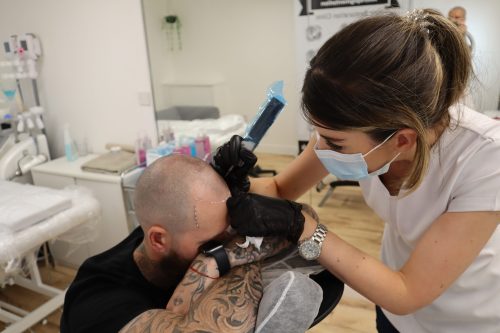
Inside the Hair Tattoo Process: What to Expect from SMP
Before committing to an SMP treatment, it’s important to understand the process. Hair tattoos are typically completed over several sessions, each spanning a couple of hours, depending on the size of the area being treated.
The first step is a consultation where the SMP artist will map out the hairline, covering the client’s concerns and aesthetic goals. The practitioner then uses a specialized machine to embed pigment into the scalp. Depth control and needle selection are critical to maintaining the appearance of natural hair follicles.
The number of sessions required depends on the complexity of the treatment. However, many clients achieve their desired results after three to four sessions. There is minimal downtime, and clients can typically return to work the following day. The treated area will appear slightly red before settling into the final appearance.
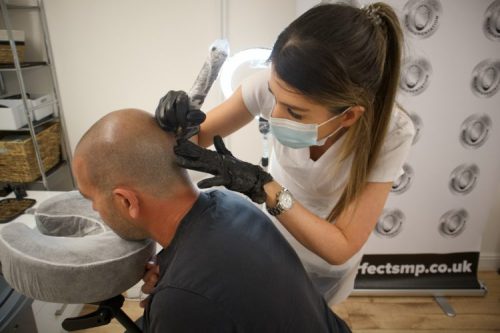
The Artistry of SMP: Skills of the Hair Tattoo Practitioner
For patients seeking SMP, the artistic eye and skill of the practitioner are just as important as the technology and equipment used. Unlike other medical procedures which have strict guidelines and standardized techniques, the finesse of the SMP artist is key in delivering natural-looking results.
To understand the critical role of artistry in SMP, it’s imperative to appreciate the art behind the technique. SMP artists are more than skilled technicians. They are artists with a canvas more alive and complex than mere ink and skin. Understanding color theory, fine lines, shading, and the proportions of the human face is indispensable. Their work adheres to the same principles as traditional art, turning a blank palette into a living, breathing masterpiece.
The learning curve for a true SMP artist is not dissimilar to that of a painter. Just as an artist’s canvas holds the possibilities and limitations of each brushstroke. So does the human scalp for an SMP procedure. Years of experience allow an artist to understand the nuances of different skin types, hair colors, and the unique contours of each client’s skull. The more experienced the artist, the more harmonious the end result.
Holistic Micropigmentation Experience
An artist with holistic micropigmentation experience brings an underlying emotional intelligence that is attuned to the clients journey. Working closely with clients during eyebrow and lip tattooing, an artist develops an understanding of the personal significance of their work. This connection, rooted in empathy and emotional intelligence, is vital in the often-intimate process of scalp micropigmentation. It helps in building trust and ensuring the client’s comfort.
Rebbeca Brown At Permanent Perfection Aesthetics is one such artist.
The practitioner’s role includes:
- Understanding pigmentation
- Artistic design of the hairline, follicle spacing, and hair colour matching
- An ability to mimic the natural hair pattern
- Understanding clients goals and translating them into tangible results
- Proving a supportive and confidence enhancing environment and service
The success of the procedure hinges on making the scalp appear as though it’s hosting natural stubble. That is expertly crafted to suit the unique features of the client’s face and skin tone.

Maintenance and Aftercare: Keeping Your SMP Fresh
An advantage of SMP is its low-maintenance nature. However, that doesn’t mean zero maintenance. Clients are advised to follow best practices to ensure the longevity and vibrancy of their hair tattoo. After the initial sessions, there’s a healing period where the scalp must be kept clean and dry.
Over time, clients must:
- Protect the scalp from prolonged sun exposure
- Use sunscreens or hats to prevent fading of the pigments
Regular touch-ups every few years are typical to maintain the desired appearance and account for natural changes in skin and hair.
Dispelling the Myths: Addressing Common Misunderstandings
Misinformation and scepticism are common with any new or lesser-known treatment. For SMP, a few common myths persist:
- It’s the same as traditional tattooing: While the basic process of implanting pigment is similar. The technique, equipment, and artistry required in SMP are unique to the field.
- It’s only for severe hair loss: SMP can be adjusted to suit any level of hair loss and is not exclusively for those with extensive balding.
- It’s not a permanent solution: The results are indeed long-lasting, but eventual fading due to natural skin turnover occurs. Periodic touch-ups are part of the maintenance.
Clearing up these misconceptions is central to helping potential clients make an informed decision.
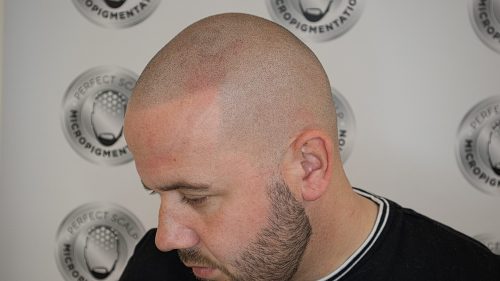
The Emotional Impact: More Than Skin Deep
Hair loss can have profound effects on self-esteem and mental health. The emotional element of SMP cannot be overstated. For many, the renewed confidence and change in appearance offer a psychological lift that extends well beyond the physical transformation.
The emotional journey for clients includes:
- Anticipation and preparation for the changes
- The immediate post-procedure aesthetics and reactions
- The gradual psychological and emotional adjustment to the new appearance
Supporting individuals through this process is just as crucial as the procedure itself.
The Cost of Confidence: Understanding the Investment
Another common consideration is the cost. SMP is best thought of as an investment that offers significant savings when compared to the ongoing costs of other hair-loss remedies.
The cost factors include:
- The area to be treated
- The number of sessions necessary
When evaluating the costs, it’s essential to consider the quality of the practitioner. Additionally, the reputation of the clinic, and the levels of service and support offered are of paramount importance.
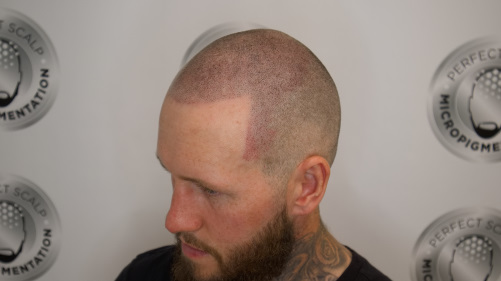
Common Hair Tattoo FAQs
How Does it Work?
An SMP treatment is typically conducted over three to four sessions, each lasting two hours. A practitioner will carefully apply the pigments in layers, building up the tone and density to replicate the natural growth pattern of hair. The end result is a subtle and indistinguishable illusion of a full, even hairline.
Is It Painful?
One of the most attractive aspects of SMP is its minimal discomfort. Some clients may experience mild discomfort. However, as the scalp has less nerve endings than other areas, the process is generally tolerable.
Who Is an Ideal Candidate?
Hair tattoos are suitable for anyone looking to address the visual impact of hair loss, regardless of gender, age, or the stage of hair loss. Individuals who may not be ready or eligible for other treatments like hair transplants or are seeking to increase the visual density post-transplant can also benefit from SMP.
Is SMP Permanent?
Scalp micropigmentation is considered a semi-permanent solution. Over time, the pigments may fade, requiring touch-up sessions to maintain the desired shade and density. A well-maintained SMP treatment can last for several years before significant fading occurs.
What is the Recovery Process?
Post-treatment, the scalp may appear slightly red and feel tender for a day or two, but these effects subside quickly. Patients are advised to keep the treated area clean and avoid the sun or swimming for a brief period. The practitioner will provide detailed aftercare instructions to ensure optimal healing and pigment retention.
Common Hair Tattoo FAQs
How Does it Work?
An SMP treatment is typically conducted over three to four sessions, each lasting two hours. A practitioner will carefully apply the pigments in layers, building up the tone and density to replicate the natural growth pattern of hair. The end result is a subtle and indistinguishable illusion of a full, even hairline.
Is It Painful?
One of the most attractive aspects of SMP is its minimal discomfort. Some clients may experience mild discomfort. However, as the scalp has less nerve endings than other areas, the process is generally tolerable.
Who Is an Ideal Candidate?
Hair tattoos are suitable for anyone looking to address the visual impact of hair loss, regardless of gender, age, or the stage of hair loss. Individuals who may not be ready or eligible for other treatments like hair transplants or are seeking to increase the visual density post-transplant can also benefit from SMP.
Is SMP Permanent?
Scalp micropigmentation is considered a semi-permanent solution. Over time, the pigments may fade, requiring touch-up sessions to maintain the desired shade and density. A well-maintained SMP treatment can last for several years before significant fading occurs.
What is the Recovery Process?
Post-treatment, the scalp may appear slightly red and feel tender for a day or two, but these effects subside quickly. Patients are advised to keep the treated area clean and avoid the sun or swimming for a brief period. The practitioner will provide detailed aftercare instructions to ensure optimal healing and pigment retention.
The Benefits of Hair Tattoos
The rising popularity of scalp micropigmentation can be attributed to its various benefits. Let’s explore how hair tattoos offer a unique advantage over traditional hair loss treatments.
Non-invasive Alternative
Hair transplant surgeries, while effective, can be invasive and require a significant recovery period. SMP, by contrast, is a non-surgical treatment that does not involve the removal of hair follicles. This minimally invasive approach allows for a swift recovery, with many clients returning to their normal routines the following day.
Immediate Results
Unlike other treatments where results are gradual, SMP provides instant gratification. Once the sessions are complete, the full effect of a restored, natural-looking hairline is immediately visible. This quick turnaround can have a profound impact on a patient’s self-esteem and psychological well-being.
Cost-Effective
Compared to the ongoing maintenance and costs associated with other treatment options, hair tattoos are an affordable investment. The initial outlay for SMP is often lower, and the treatment requires little to no additional spending for at least a year, making it an attractive long-term solution.
Customizable and Natural Looking
Hair tattoos are highly customizable. This means that practitioners can match the treatment to a client’s natural skin tone and hair colour, resulting in a realistic and undetectable appearance. The attention to detail in mimicking the angle and distribution of natural hair follicles ensures the finished result is both authentic and personalized.
Hairline Redefinition and Scar Concealment
SMP can also redefine and lower a receding hairline, giving the face a more youthful and balanced appearance. Additionally, it is effective in disguising scars on the scalp. Including those from hair transplants or accidents, providing a uniform and seamless look.
Hair Tattoo vs. Hair Transplants:
Understanding Hair Transplants
Hair transplants work by harvesting hair follicles from the back or side of the head and implanting them into balding areas. This surgical procedure may offer a permanent solution to restore hair growth. As the transplanted hair follicles are not affected by the balding process. It’s a time-consuming and costly endeavour, which often requires multiple sessions to achieve the desired density.
The Downside of Hair Transplants
Despite its efficacy, hair transplant surgery has its downsides. First, it is a medical procedure that carries the typical risks associated with any surgery. Including the possibility of infection or poor wound healing. Second, not everyone is a candidate for a hair transplant, particularly if the individual’s hair loss is too far advanced or if they lack sufficient donor hair.
The recovery time for a hair transplant can range from a few days to several weeks, depending on the extent of the procedure. Additionally, there is often a ‘shock loss’ period after the surgery. This is when the transplanted hair falls out before new hair begins to grow, making the timeline for seeing full results quite lengthy.
Deciding on SMP or a hair transplant is a personal choice that should be made after careful consideration of several factors. These include cost, desired outcome, health, and lifestyle.
Your Goals
Before deciding, consider what you hope to achieve with hair restoration. Hair transplants typically offer permanent solution for hair loss. However, they require a significant investment in time and money. On the other hand, if a close-cropped look is sufficient and you’re looking for a minimally invasive procedure. SMP is by far the more favourable choice.
Health and Lifestyle
Your current health and lifestyle can also influence your decision. SMP may be the preferred option for those who want to avoid the risks and recovery of surgery. Or for individuals who are not candidates for a hair transplant. Additionally, if you have a more active lifestyle or struggle with clotting disorders, the non-surgical nature of SMP can be a safer route.
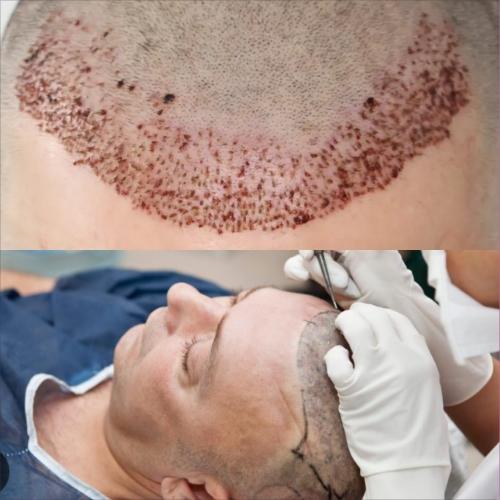
Hair Tattoo vs. Hair System
Hair systems, have a long history of use and have traditionally been a go-to solution for concealing hair loss. They are available in different styles, materials, and attachment methods, designed to cater to a variety of preferences and needs.
Types of Hair Systems
The variety in hair systems is truly extensive. From lace front wigs that provide a natural hairline to skin-based designs that simulate the scalp’s texture. They can be made from synthetic materials or human hair. The latter offering a more authentic appearance and touch.
Maintenance and Durability
Hair systems require more upkeep than SMP. Such as regular cleaning, conditioning, and occasional refitting. The lifespan of the system typically ranges from several months to a year.
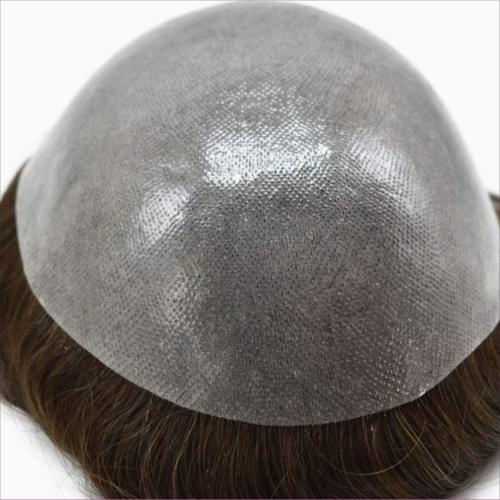
Benefits of a Hair Tattoo Over a Hair System
The two approaches have distinct advantages that appeal to different user groups. However, a hair tattoo carries unique benefits that can prove to be determining factors for many individuals.
Non-Invasive and Cost-Effective
A hair tattoo is a one-time investment that requires minimal intrusion, unlike a hair system that might demand ongoing maintenance and higher costs over time. The cost-benefit analysis reflects positively on SMP, especially for long-term users.
Aesthetic Freedom
SMP allows for the freedom of different haircuts and styles, as it doesn’t limit users to the look of a full head of hair like a hair system might. It also presents the possibility of a close-shaved head aesthetic, a style that’s less attainable with a hair system.
Authenticity and Lifestyle Fit
With SMP, the worry of exposure to elements or activities that a hair system might not withstand is removed. The pigments remain steadfast, providing a consistent look regardless of lifestyle. For individuals who lead active lives, this reliability is a significant draw.
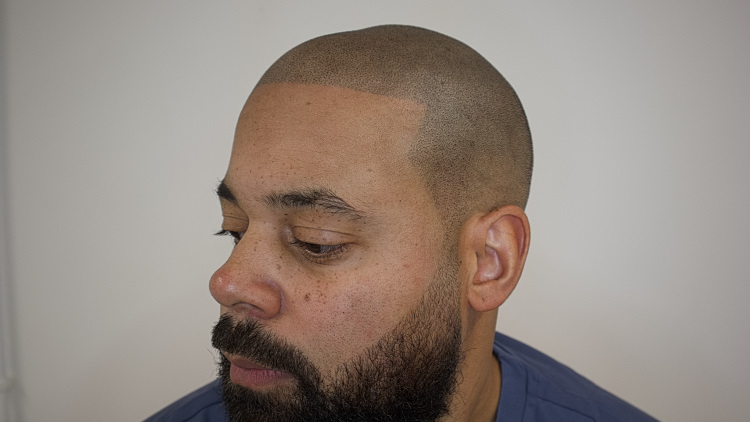
Is a Hair Tattoo the Right Choice for You?
Choosing between a hair tattoo and a hair system depends on a range of factors, including your budget, lifestyle, level of hair loss, and aesthetic preferences. When contemplating SMP, keep the following in mind:
Level of Hair Loss
For those with advanced levels of hair loss, a hair tattoo might not be as effective, as it uses the existing hair to create volume and density. In such cases, a hair system could offer a more comprehensive cover.
Desired Aesthetic
Consider the look you wish to achieve. SMP may be a better fit for those looking for a closely shaved head appearance or an athletic lifestyle, while a hair system could be preferred by those who enjoy experimenting with different hairstyles.
Longevity and Maintenance
Think about your long-term commitment and the level of maintenance you are willing to undertake. A hair system might offer a more temporary solution, which can be beneficial if you’re unsure about a permanent change. However, for those seeking a long-term, low-maintenance option, SMP could be the way forward.
Consultation Is Key
Regardless of your choice, the importance of professional consultation can’t be overstated. A specialist can guide you towards the most suitable option based on your individual circumstances and desired outcomes.
Ensuring a Secure Hair Tattoo Experience
SMP may be non-invasive, but it’s essential to undergo the treatment with the same level of scrutiny and consideration as any medical procedure. As such, ensuring the clinic and artist adhere to stringent health and safety standards and are licensed is non-negotiable.
Safety considerations must include:
- The practitioner’s qualifications and experience
- The hygiene practices and the sterilization of equipment
- The client’s medical history and potential contraindications
Regulation within the SMP industry is evolving, and staying informed about best practices is crucial.
Considerations and Contraindications: Who Should Avoid SMP?
Not everyone is a candidate for SMP. Understanding the potential risks and contraindications is essential for a thorough consultation and decision-making process.
Situations that may preclude individuals from SMP include:
- Allergies to tattoo ink or pigment ingredients
- Keloid scarring
- Underlying skin conditions of the scalp
The Future of SMP: Evolving Techniques and Technology
As with any burgeoning field, SMP is not static. Ongoing advancements in technology, pigment formulations, and techniques promise an exciting future for this rapidly growing industry.
The future may bring:
- Advanced application methods for even more natural results
- A widening scope of applications for different types of hair loss
The Future of SMP: Evolving Techniques and Technology
As with any burgeoning field, SMP is not static. Ongoing advancements in technology, pigment formulations, and techniques promise an exciting future for this rapidly growing industry.
The future may bring:
- Advanced application methods for even more natural results
- A widening scope of applications for different types of hair loss

In Conclusion: Embracing the Potential of a Hair Tattoo
For individuals navigating the complexities of hair loss, a Hair Tattoo presents a unique blend of art and science—a combination with clear potential to sculpt a new image and confidence. Understanding the intricacies of hair tattoos allows those within the hair loss community to make informed decisions, manage expectations, and perhaps, uncover a transformative solution.
By embracing a Hair Tattoo for what it is—an innovative and creative means to tackle a common issue—both clients and practitioners can work together to create bespoke, life-changing results. Whether as a standalone treatment or part of a broader hair restoration journey, SMP is poised to make a significant contribution to the field. As practitioners refine their art and technology continues to advance, the canvas for hair tattoos is expanding, offering a brighter, more vibrant image for those in search of a hair loss solution.

Recent Comments